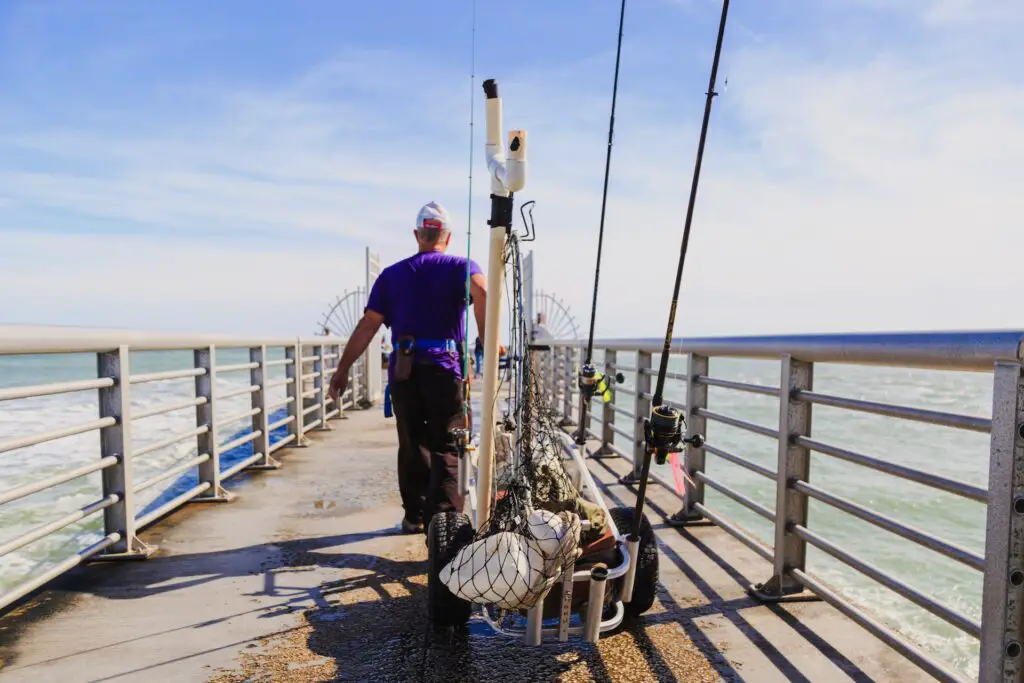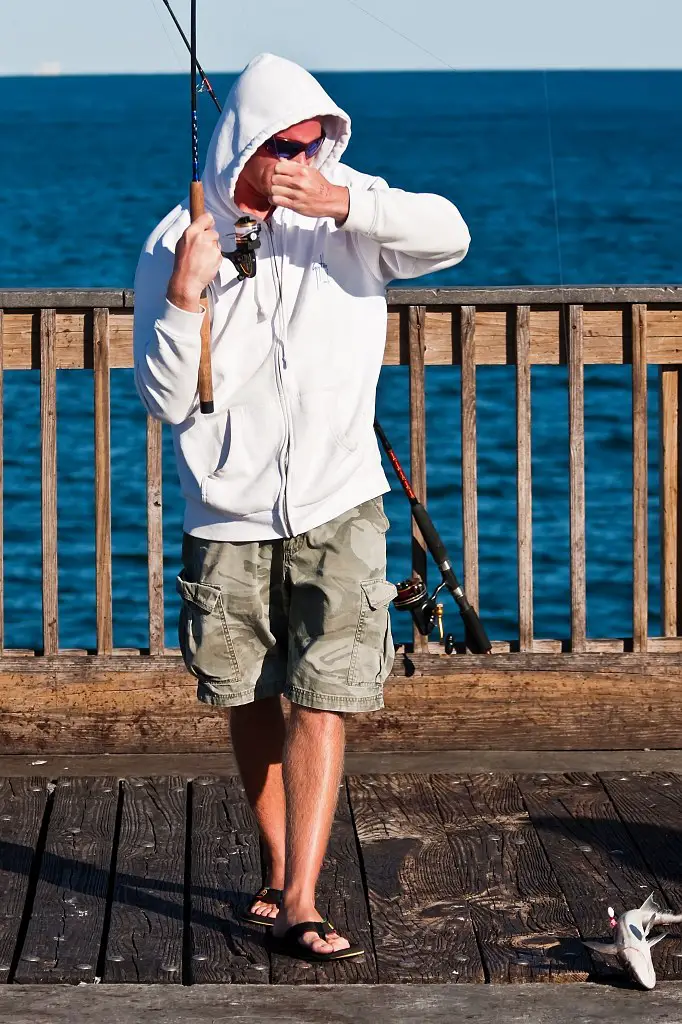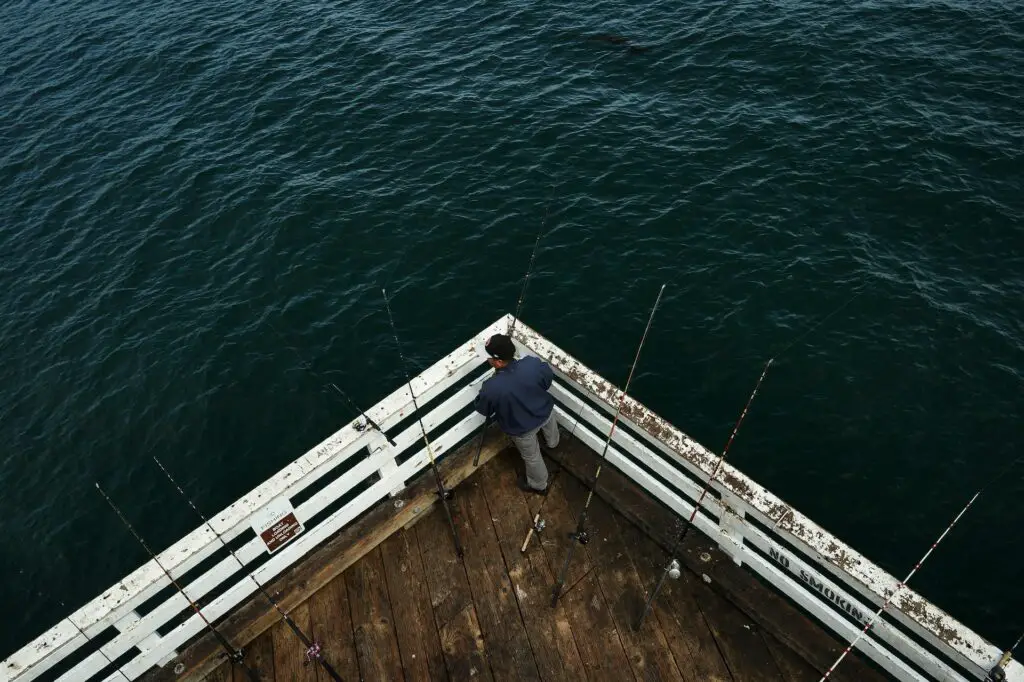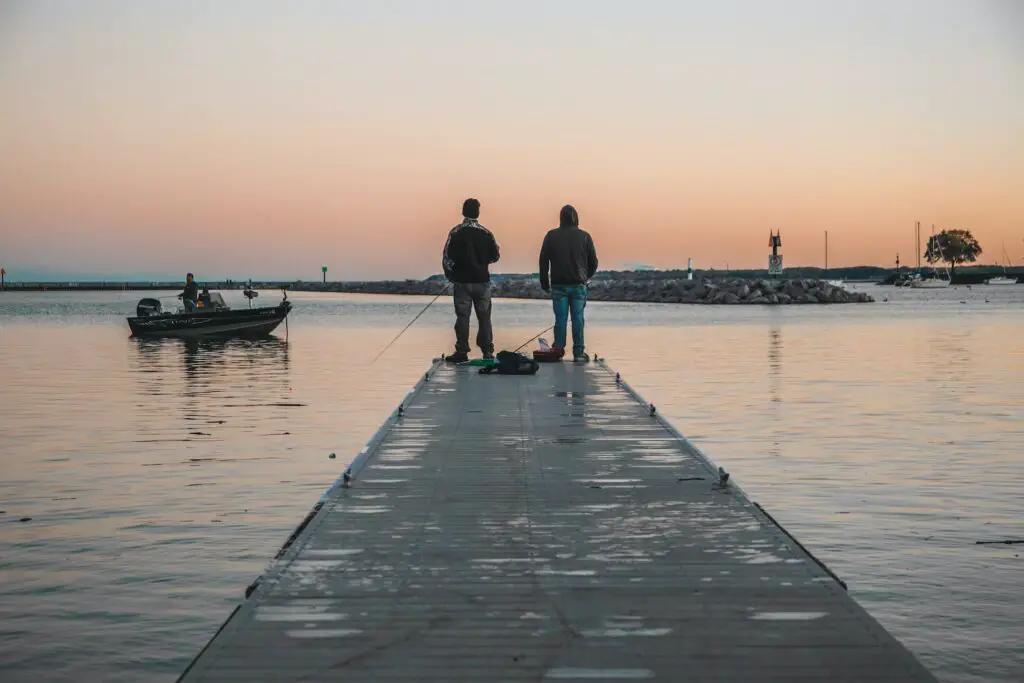Pier fishing is a blend of shore fishing and boat fishing. You might say that it’s the best of both worlds. Pier fishermen have easy access to solid ground and no risk of seasickness while enjoying all the benefits of direct over-water access as boat anglers.
If you are interested in fishing piers and want to learn more about them, all you need to do is keep scrolling. I have done my best to gather all the relevant info you need to have a productive and enjoyable fishing trip to one of your local fishing piers. I have also included some excellent pier fishing tips and tricks!
All You Need To Know About Pier Fishing

Fishing piers attract fish – it is a well-known fact. Due to the marine growth that characterizes these large submerged water structures, they attract tiny baitfish that, in turn, attract large fish that feed on them. However, these fish won’t jump into your bucket by themselves. You need a proven pier fishing tactic!
To be a successful pier angler, you ought to figure out the best time to fish based on seasonality, the best species to target, and the best gear, tackle, bait, and lures to bring. Let’s do it together.
The Best Time & Place To Fish From A Pier

It is not enough to simply show up at your local pier. You also need to be there at the right time.
From my experience, the best time for fishing from a pier is two or three hours before the high tide, especially in spring. I have also had a lot of success fishing about two hours after the high water. You should best avoid the exact period of the high water, though. It is not nearly as advantageous.
As far as the time of the day is concerned, you do not need your watch. Fish have no timepiece, either. Instead, they base their activity on current light conditions. More precisely, fish are less guarded and more active in low light.
Consequently, dusk and dawn are the best options for catching fish. I prefer fishing in the early morning, but if you are not an early bird, you can go to your favorite fishing pier later in the afternoon, too.
If you wish to improve your catch rate, get a local tide chart and find the most recent dusk or dawn tide highs. Also, try to scout the fishing pier surroundings during the low tide. It will help you pinpoint the rocks and troughs around it that are the best areas to cast your bait in and catch fish.
You must also decide which side of the fishing pier to fish on. Even though many anglers prefer the downtide side because it keeps their terminal tackle safe from being swept under the pier, fishing the side that faces the tide is far more productive. Fishing on the uptide side of a fishing pier enables fish to detect the scent of your bait more easily. Besides, the tide keeps your sinker anchored to the bottom.
You can also have success fishing from the end of the pier, especially if you hope to catch bigger fish. The deeper water in this area is likely to host larger fish. It is not always the case, though. Depending on the location and the surroundings of the fishing pier, fish might choose to hide or feed closer to the shore, especially if there is a drop-off or some underwater structure, such as a rock.
As far as ocean piers go, it is always wise to cast your bait just behind the surf line. It will be more productive than casting it farther out. You’ll strike gold if you can locate a mussel bed or a patch of broken ground within your casting range.
As far as the choice of a fishing pier goes, it is best to ask around among fellow pier anglers or at the local tackle shop. Some piers, such as Crystal Pier located on the Pacific Beach in San Diego, offer the stay-on-the-pier and over-the-water cottages that are perfect for a whole-day fishing trip.
Once you make a choice, check if fishing from a chosen pier requires a fishing license. Most public fishing piers can be fished without a fishing license, but that is not always the case. Better be safe than sorry. Besides, if you hook a big fish on the pier and want to come down to the beach to land it, you’ll have to have a license, or you might be in trouble. In my opinion, if you are an avid fisherman, you should best consider buying an annual fishing license.
Some piers require you to pay an entrance fee, a fishing fee, or even both. It can be a deal-breaker if you are on a really tight budget.
The Best Pier Fishing Gear

Once you find fish, it is time to catch it. Here is the list of the essential gear you need to get started fishing from a pier:
Fishing Rod & Reel
Your fishing rod and reel must match the fish species you are targeting. You should best get a somewhat heavier tackle, though, since you’ll need extra power and strength to lift the fish up to the pier.
Generally speaking, a basic medium-heavy spinning or casting rod made from graphite or fiberglass will do the trick. I have also seen anglers using other types of rods, even fly fishing rods, so you might try that too.
The rod should be 7 to 9 feet long and 12 to 50-pound tested. In my experience, the shorter rods are more sensitive and easier to handle. Pair your rod with a 2500-3000 reel that can fit 150-200 yards of 10-15 lb mono line.
Fishing Hooks
Your hook should match the size of your bait and the fish species you are targeting. If you want to be flexible, carry different size hooks in your tackle box. When fishing from a pier, you’ll most likely use sizes 4/0 to 2/0. I like using a three-way swivel with a leader hook.
Fishing Weights
Fishing weights or sinkers help keep your bait in the bite zone and at the desired depth. I personally think that everyone should pack at least a few different sinkers weighing from 1 to 6 ounces.
Drop Net
A hoop net, pier net, or drop net is an excellent alternative to heavy tackle. It allows you to haul bigger fish, such as kingfish, California corbina, or black drum, out of the water without the risk of your line or rod snapping under the pressure.
Fishing Pliers With A Line Cutter
Having fishing pliers is always convenient as it eliminates the need to use your teeth when cutting your lines or removing hooks. It keeps you safe from injury too. If you are fishing from a beach pier, make sure the pliers you buy are corrosion-resistant.
Rod Holders
Speaking from personal experience, rod holders are your best allies when fishing from a pier. Having two rod holders not only allows you to enjoy a hands-free fishing experience but also doubles your odds of success.
You do not have to spend money at all. You can make your rod holders by yourself, just like I do. Watch the video below to find out how to do it:
Portable Chair
If you took my advice and got a couple of rod holders, you can sit back and enjoy yourself. To do that, you’ll need to have a chair. I usually bring a lightweight picnic chair, but there are also specialized fishing chairs. My main criterion is a drink holder!
Sun Protection
Most piers offer no shade. You have to protect yourself from hurtful UV radiation. Wearing a hat, sunscreen cream, and polarized sunglasses can help you avoid trouble. In my experience, polarized sunglasses also enable you to see below the water’s surface and spot the fish more easily.
Fishing Cart
To make your fishing experience even easier, get a fish cart and store all your equipment in one place. Many models come with a live well that you can use for keeping the fish you catch alive. Other useful features you should consider are adjustable handles, multiple rod holders, and tool racks.
Fishing License
I must remind you once again – do not forget to check your state regulations and ensure you have the appropriate fishing license! I also always check the size and bag limits for the species I am targeting. You should be able to find this info at your state’s official fisheries department.
The Best Pier Fishing Rigs

Based on my experience, using the right fishing rig at the right time greatly improves a hook rate. Here is the list of tried and tested rigs you can use when fishing from a pier:
Paternoster Rig
A paternoster rig or a chicken rig is a highly versatile multi-hooked bottom fishing rig that many anglers use when fishing from a boat or a pier. I have often seen it used at San Diego piers.
Watch the following video to learn how to tie a paternoster rig:
Carolina Rig
A Carolina rig is one of the most popular and versatile rigs that can be used for many fishing techniques. You can use it when fishing from a pier, too. To tie it, you’ll need an 18 inches long leader, a hook, a swivel, a fishing sinker, and some plastic beads. You’ll also need to learn how to tie a Palomar knot.
Three-Way Rig
A three-way rig is a simple rig that requires you to have a three-way swivel, a fluorocarbon leader attached to a hook, and a dropper line that holds a fishing weight and anchors your bait to the bottom. It can be used for fishing natural live and artificial bait in shallow and deep water. To learn how to tie it, check out the video below:
Monster Rig
As its name suggests, the monster rig is the best fishing rig for targeting sea monsters. It requires a 2 to 4-ounce heavy sinker, a 16/0 or 20/0 size hook, and a 2-pound heavy live bait.
Floating Rig
When fishing from a pier, a floating rig can help you score more fish. It allows your bait to float naturally with the tide and appear less intimidating to apprehensive fish. To tie it, you will need a piece of mono line, a few plastic beads, a float, a sinker, a small split ring, a black barrel swivel, and a Kahle hook.
This video will teach you how to set up a floating rig:
Fish Finder Rig
A fish-finder rig is a highly versatile still fishing rig that can be used for fishing in the surf or from a beach pier. You can use it to free-line live bait or fish cuts. It calls for an 18 inches long leader line, a swivel, a hook, a pyramid sinker, and a few beads. Here is how to set it up:
The Best Bait For Fishing From A Pier

Your choice of bait does not depend much on whether you are fishing from a local pier or surf fishing. It is determined by the fish species you are targeting. In my experience, it is always highly advantageous to visit a local tackle shop and ask which are the best-selling bait or lures as they probably work the best too.
In general, if you fish from a beach pier, you cannot go wrong with any of the following bait:
- Bloodworms
- Shrimp
- Squid
- Anchovies
- Sardines
When using live bait, consider investing in a bait bucket with an aerator to keep them alive and active. The more active they are, the more fish will they lure.
As far as lures are concerned, I recommend trying the following:
- Popping plugs
- Pencil jigs
- Bucktail jigs
- Soft-bodied lead head jigs
- Casting spoons
- Jigging spoons
- Chatterbait
A Few Additional Pier Fishing Tips & Tricks

- You should not simply cast your bait and wait for the bite. Be active! Moving your rig along the bottom allows you to cover more water and is likely to attract more fish and improve your catch rate.
- Be prepared for every situation by bringing a light tackle setup for good weather conditions and a heavy tackle setup for rough conditions and big game fish.
- Try to match the hatch by finding out which baitfish dominate the area.
- Before you cast your bait, check if you are jeopardizing someone close to you. Piers are often crowded. Besides, most of the time, there is no need to cast at all since fish are directly under you
- If you are lucky enough to have your private pier, set up an oyster float or two. Growing oysters improves water quality and attracts minnow, grass shrimp, and small crabs, that, in turn, attract more fish.
- You do not have to purchase a new rod to fish off the beach pier. Most surf fishing rods can serve the purpose.
FAQs
What is the best bait for pier fishing?
The best bait for pier fishing is live bait. There are numerous options, such as squid, bloodworms, shrimp, anchovies, or sardines. You should always try to match the hatch so ask around which baitfish dominate the area you are fishing in.
What is the best time to fish off a pier?
The best time to fish off a pier is either dawn or dusk. So, if you cannot get up early in the morning, go fish at sundown. You should also check the local tide chats and try to fish two or three hours before (or after) the high tide.
Is pier fishing easy?
Pier fishing is easy since it gives anglers direct over-water access. Besides, piers attract all sorts of fish. Everyone should give it a go at least once.
What size rod is best for pier fishing?
The best size rod for pier fishing is a 7-foot medium-heavy rod. Graphite or fiberglass should do the trick.
What size hook should I use for pier fishing?
You should use a 4/0 to 2/0 size hook for pier fishing. These hooks work with most bait. Ensure that you choose a hook size that corresponds to the fish species you are targeting.
My Final Thoughts

As you can see, fishing from a pier is no brain science. After all, all piers attract an abundance of fish; all you have to do is bring the right gear and tackle to fish it out. Beginner anglers can give it a try, too, as well as kids, so you can make it a family experience.
If you have something to add, or you want to share your experience fishing off the pier, use the comment section below. I am always here to hear you out.
